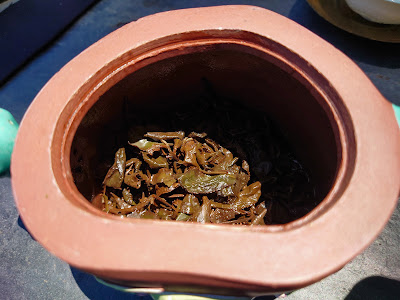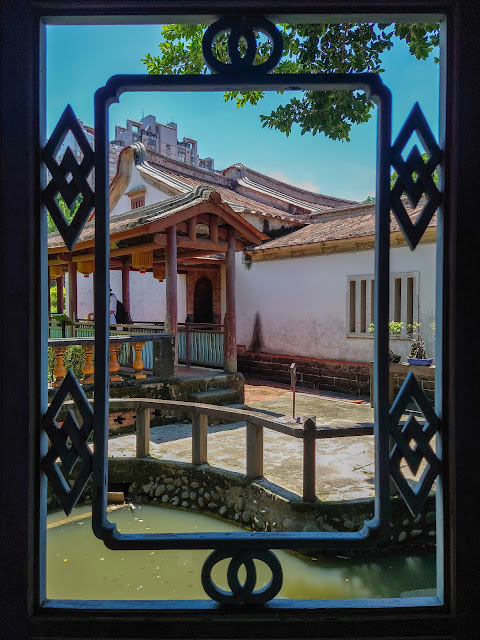 |
| Alishan Jinxuan Oolong from spring 2024 |
"Necessity is the mother of invention" or in this case it's not more an adaptation than an invention. I'm speaking of the way I'm brewing tea in the Lin Gardens (in Banciao, Taiwan). Heating water isn't allowed, so the only way to brew tea on site is to go to a water fountain which dispenses boiling water (for free). The challenge is that this fountain is located in a corner of the gardens. It's 20 meters or more away from where I set up my Chaxi. So, it's not convenient to use a small vessel and make lots of back a forth. One solution would be to fill a Thermos with boiling water. This is the solution I've seen implemented in Sichuan, China in 2016. It works well, because most green teas do well with water that has cooled down a bit.
My solution is to use this rather large (antique) Yixing teapot. The Yixing clay retains heat very well. It's large enough for the equivalent of 3 brews. This means, with one fill, we get to experience the leaves in 3 styles: with a medium brew, a long brew and a very long brew! This isn't the ideal way to prepare tea, of course, but I found it interesting to test my leaves and see how they'd taste under such circumstances. Also, I used this method on a tea friend who owns a tea house. A professional tea taster is more used to drink a great variety of teas with varying degrees of strength. This is a way to test the quality of the teas.
We started with 2 light oxidized Oolong: my 2024 spring Jinxuan from Alishan and my 2023 spring 'subtropical forest' Wenshan Baozhong. The Jinxuan amazed me with it consistency. Over brewing it (in the third pour) made it simply stronger, but didn't make it bitter, and the lightness of the first pour was light and refreshing on this sunny day! Baozhong tea is more likely to age fast, because leaves aren't rolled and are thus more in contact with air. However, this pack (that I've opened for several weeks already) has retained it freshness and zesty feel.
The next tea I brewed was my summer 2023 Oriental Beauty Oolong Tradition from Hsin Chu. By coincidence, I was able to take a picture of 2 traditionally clothed oriental beauties in the same frame!! Actually, with this method, we had 3 different OBs coming from the teapot. The first had the lightest, most refined fragrance. The second was well balanced between the sweet taste and ripe fruit aromas. The third was intense and powerful in every aspect and extra feminine.
My solution is to use this rather large (antique) Yixing teapot. The Yixing clay retains heat very well. It's large enough for the equivalent of 3 brews. This means, with one fill, we get to experience the leaves in 3 styles: with a medium brew, a long brew and a very long brew! This isn't the ideal way to prepare tea, of course, but I found it interesting to test my leaves and see how they'd taste under such circumstances. Also, I used this method on a tea friend who owns a tea house. A professional tea taster is more used to drink a great variety of teas with varying degrees of strength. This is a way to test the quality of the teas.
We started with 2 light oxidized Oolong: my 2024 spring Jinxuan from Alishan and my 2023 spring 'subtropical forest' Wenshan Baozhong. The Jinxuan amazed me with it consistency. Over brewing it (in the third pour) made it simply stronger, but didn't make it bitter, and the lightness of the first pour was light and refreshing on this sunny day! Baozhong tea is more likely to age fast, because leaves aren't rolled and are thus more in contact with air. However, this pack (that I've opened for several weeks already) has retained it freshness and zesty feel.
The next tea I brewed was my summer 2023 Oriental Beauty Oolong Tradition from Hsin Chu. By coincidence, I was able to take a picture of 2 traditionally clothed oriental beauties in the same frame!! Actually, with this method, we had 3 different OBs coming from the teapot. The first had the lightest, most refined fragrance. The second was well balanced between the sweet taste and ripe fruit aromas. The third was intense and powerful in every aspect and extra feminine.
 |
| Open leaves of Oriental Beauty Oolong |
The nice thing is that we don't have to choose one or the other, but that we can enjoy them all!
Cheers!
My guest told me that his least preferred tea is roasted Oolong. I took this as a challenge and, since we had such a nice time, proceeded with a fourth brewing. I chose my spring 2024 charcoal roasted Dong Ding Oolong from Yong Lung. Its roasting level is much lower than its name suggests and shouldn't bother my guest. Indeed, as you can see from the first pour, the color of the brew is bright, light yellow.
Again, I was very happy with the way the tea turned out in each 3 brews. This shows that good quality tea is very versatile. It comes out great with very different parameters. This method has blurred the line between what consider the Chinese/GongFu/Eastern way (smaller vessel, shorter brews) and the Western/English method (large vessel single brew). It's also an entertaining way to better know your tea and find out how strong you like it!Cheers!







No comments:
Post a Comment